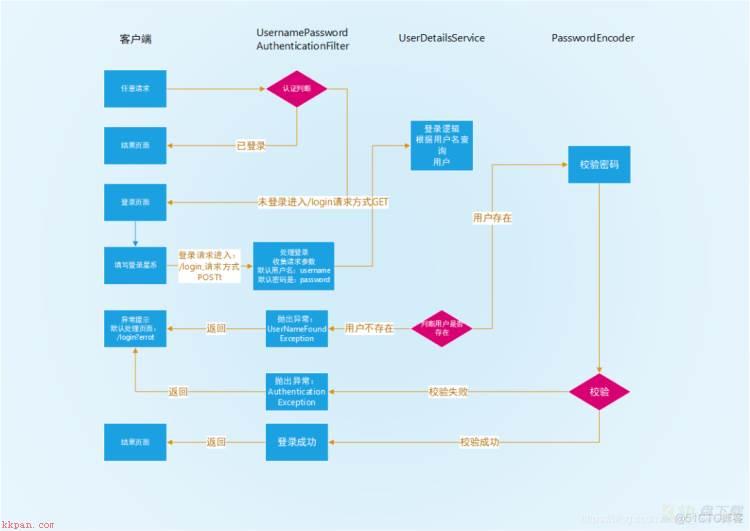今天来一篇 Spring Security 精讲,相信你看过之后能彻底搞懂 Spring Security。
Spring Security 是一种高度自定义的安全框架,利用(基于)SpringIOC/DI和AOP功能,为系统提供了声明式安全访问控制功能,「减少了为系统安全而编写大量重复代码的工作」。
「核心功能:认证和授权」

❝
「hasAuthority(String)」判断角色是否具有特定权限
❞
http.authorizeRequests().antMatchers("/main1.html").hasAuthority("admin")❝
「hasAnyAuthority(String ...)」如果用户具备给定权限中某一个,就允许访问
❞
http.authorizeRequests().antMatchers("/admin/read").hasAnyAuthority("xxx","xxx")❝
「hasRole(String)」如果用户具备给定角色就允许访问。否则出现403
❞
//请求地址为/admin/read的请求,必须登录用户拥有'管理员'角色才可访问
http.authorizeRequests().antMatchers("/admin/read").hasRole("管理员")
❝
「hasAnyRole(String ...)」如果用户具备给定角色的任意一个,就允许被访问
❞
//用户拥有角色是管理员 或 访客 可以访问 /guest/read
http.authorizeRequests().antMatchers("/guest/read").hasAnyRole("管理员", "访客")
❝
「hasIpAddress(String)」请求是指定的IP就运行访问
❞
//ip 是127.0.0.1 的请求 可以访问/ip
http.authorizeRequests().antMatchers("/ip").hasIpAddress("127.0.0.1")
1.编写类实现接口「AccessDeniedHandler」
/**
* @describe 403 权限不足
* @author: AnyWhere
* @date 2021/4/18 20:57
*/
@Component
public class MyAccessDeniedHandler implements AccessDeniedHandler {
@Override
public void handle(HttpServletRequest request, HttpServletResponse response, AccessDeniedException e)
throws IOException, ServletException {
response.setStatus(HttpServletResponse.SC_OK);
response.setContentType("text/html;charset=UTF-8");
response.getWriter().write(
"<html>" +
"<body>" +
"<div style='width:800px;text-align:center;margin:auto;font-size:24px'>" +
"权限不足,请联系管理员" +
"</div>" +
"</body>" +
"</html>"
);
response.getWriter().flush();//刷新缓冲区
}
}
2.配置类中配置exceptionHandling
// 配置403访问错误处理器。
http.exceptionHandling().accessDeniedHandler(myAccessDeniedHandler);/
@Configuration
@EnableWebSecurity
public class SecurityConfig extends WebSecurityConfigurerAdapter {
@Override
protected void configure(HttpSecurity http) throws Exception {
//配置记住密码
http.rememberMe()
.rememberMeParameter("remember-me") // 修改请求参数名。 默认是remember-me
.tokenValiditySeconds(14*24*60*60) // 设置记住我有效时间。单位是秒。默认是14天
.rememberMeCookieName("remember-me") // 修改remember me的cookie名称。默认是remember-me
.tokenRepository(persistentTokenRepository) // 配置用户登录标记的持久化工具对象。
.userDetailsService(userSecurity); // 配置自定义的UserDetailsService接口实现类对象
}
@Bean
public PersistentTokenRepository persistentTokenRepository(DataSource dataSource){
JdbcTokenRepositoryImpl jdbcTokenRepository = new JdbcTokenRepositoryImpl();
jdbcTokenRepository.setDataSource(dataSource);
//jdbcTokenRepository.setCreateTableOnStartup(true);
return jdbcTokenRepository;
}
}
❝
角色校验 ,请求到来访问控制单元方法时必须包含XX角色才能访问
角色必须添加ROLE_前缀
❞
@Secured({"ROLE_管理员","ROLE_访客"})
@RequestMapping("/toMain")
public String toMain(){
return "main";
}使用注解@Secured需要在配置类中添加注解 使@Secured注解生效
@EnableGlobalMethodSecurity(securedEnabled = true)
❝
权限检验,请求到来访问控制单元之前必须包含xx权限才能访问,控制单元方法执行前进行角色校验
❞
/**
* [ROLE_管理员, admin:read, admin:write, all:login, all:logout, all:error, all:toMain]
* @PreAuthorize 角色 、权限 校验 方法执行前进行角色校验
*
* hasAnyAuthority()
* hasAuthority()
*
* hasPermission()
*
*
* hasRole()
* hasAnyRole()
* */
@PreAuthorize("hasAnyRole('ROLE_管理员','ROLE_访客')")
@RequestMapping("/toMain")
@PreAuthorize("hasAuthority('admin:write')")
public String toMain(){
return "main";
}
使用@PreAuthorize和@PostAuthorize需要在配置类中配置注解@EnableGlobalMethodSecurity 才能生效
@EnableGlobalMethodSecurity(prePostEnabled = true)
❝
权限检验,请求到来访问控制单元之后必须包含xx权限才能访问 ,控制单元方法执行完后进行角色校验
❞
/**
* [ROLE_管理员, admin:read, admin:write, all:login, all:logout, all:error, all:toMain]
* @PostAuthorize 角色 、权限 校验 方法执行后进行角色校验
*
* hasAnyAuthority()
* hasAuthority()
* hasPermission()
* hasRole()
* hasAnyRole()
* */
@PostAuthorize("hasRole('ROLE_管理员')")
@RequestMapping("/toMain")
@PreAuthorize("hasAuthority('admin:write')")
public String toMain(){
return "main";
}
<dependency>
<groupId>org.springFramework.boot</groupId>
<artifactId>spring-boot-starter-thymeleaf</artifactId>
</dependency>
<dependency>
<groupId>org.thymeleaf.extras</groupId>
<artifactId>thymeleaf-extras-springsecurity5</artifactId>
</dependency>
CSRF(Cross-site request forgery)跨站请求伪造,也被称为“One Click Attack” 或者Session Riding。通过伪造用户请求访问受信任站点的非法请求访问。
跨域:只要网络协议,ip地址,端口中任何一个不相同就是跨域请求。
客户端与服务进行交互时,由于http协议本身是无状态协议,所以引入了cookie进行记录客户端身份。在cookie中会存放session id用来识别客户端身份的。在跨域的情况下,session id可能被第三方恶意劫持,通过这个session id向服务端发起请求时,服务端会认为这个请求是合法的,可能发生很多意想不到的事情。
通俗解释:
CSRF就是别的网站非法获取我们网站Cookie值,我们项目服务器是无法区分到底是不是我们的客户端,只有请求中有Cookie,认为是自己的客户端,所以这个时候就出现了CSRF。
------